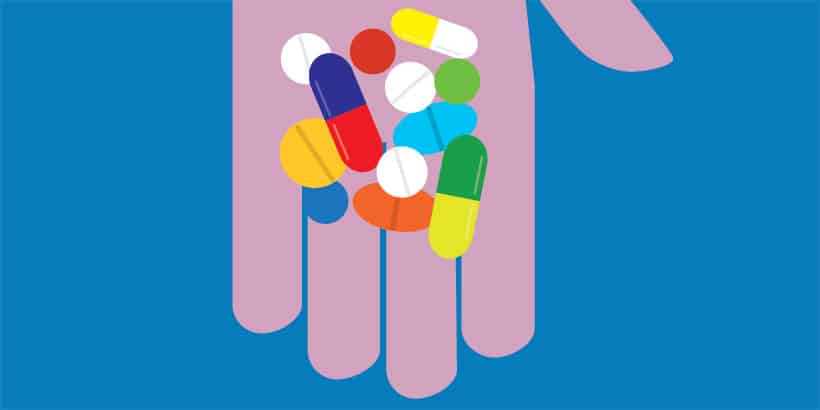
GP Crisis
March 15, 2023
Fee dodgers
March 15, 2023FEATURE
Antimicrobial resistance
Antimicrobial stewardship has never been more important. Without intervention, antimicrobial resistance could be responsible for 10 million excess deaths globally by 2050.
We are all too familiar with the phrase ‘too much of a good thing’, an adage which has become increasingly synonymous with antimicrobial drugs in the past number of years. Considered one of the most significant medical achievements of the 20th century, antibiotic overuse and subsequent resistance to these drugs has since been labelled by the World Health Organisation as one of the top 10 global threats to health.
Antimicrobial resistance (AMR) is spreading in ways that are becoming increasingly difficult to detect and manage. Researchers at the University of Western Australia have found a novel mechanism of resistance whereby Group A Streptococcus has demonstrated the ability to take folate directly from its host, rendering antibiotics such as sulfonamides ineffective. This form of resistance was found to be indistinguishable under traditional testing making it more difficult to administer targeted antimicrobial treatment. Such resistance can easily be spread among pathogens via horizontal gene transfer (HGT), enabling resistance in pathogen populations not yet exposed to antimicrobials. Key findings from 2021 data from the Australian Group on Antimicrobial Resistance (AGAR) highlight further worrying developments. These include the emergence of specific types of extended spectrum beta-lactamases (ESBLs) in E. coli in the community, a longitudinal trend of increasing resistance in gram-negative organisms, and carbapenamase-producing gram-negative pathogens.
Contrary to popular belief, AMR is arising not just from its use in human health but also from its utility in the animal and environmental health sectors, all three of which are inextricably linked in a model known as One Health. Antimicrobial use in agriculture, and veterinary and human medicine can produce antimicrobial waste which enters the environment. These points of antimicrobial entry into the environment include hospital sewage, crop spraying, livestock feed, and manufacturing effluent. This usage of antimicrobials concurrently leads to the development of antimicrobial resistant pathogens which are also released into the environment through waste, and which can share their genetic resistance factors through HGT mechanisms. These pathogens can then be transferred through a multitude of pathways, including high-altitude winds, movement patterns of wildlife, and routes of surface water, to re-enter human living spaces and environments. As such they are capable of being transferred to humans and animals through food, the environment, or by direct contact with vectors.
With resistance comes increased financial burdens on the economy. The current costs are already large enough to warrant major intervention, with Australian hospitals spending $16.8 million per year treating the five most common resistant hospital-associated infections. A resistant infection can add as much as $10,000 to the cost of treatment when compared to susceptible infections. The annual impact on the Australian economy is estimated to rise to anywhere between $142 billion to $283 billion by 2050 under a worst-case scenario.
The cost to the patient is likewise severe, with 4.95 million deaths associated with resistant bacterial infections in 2019, including deaths directly attributable to AMR. This figure is projected to rise to 10 million deaths each year by 2050, a figure tantamount to the death toll from cancer in 2020. In terms of the patient quality of life, AMR is associated with poorer outcomes, requiring stronger antimicrobials which carry greater side effects, including nerve damage, hearing loss, and organ failure. Like many diseases, the risks associated with AMR disproportionately affects patients who are vulnerable or disadvantaged.
Dr Kenneth McCroary, a general practitioner and Chair of the AMA (NSW) Council of General Practice, said part of the issue is prescription practices, stating that his LGA has the highest prescription rates of Amoxil in the country. This may be due to the high incidence of solo practitioners in his area who engage with minorities from culturally and linguistically diverse backgrounds who often have different cultural experiences with health systems and health literacy. He considers that deprescribing would require a multifaceted approach disseminated by the different levels of healthcare including local and higher levels of management. These solutions could include:
• More support in areas with higher incidence of prescribing
• Push letters from Medicare to doctors
• Better engagement of doctors that are more isolated and those that are restricted in their practice
• Developing patient programs
• Implementing collegiate gatherings
Another issue contributing to AMR is the shortage of antibiotics such as cefalexin and amoxicillin in the aftermath of the COVID-19 pandemic. This has led to patients not being treated appropriately or fast enough, and to the use of inappropriate antibiotics in their place, Dr McCroary said. The silver-lining is that the pandemic has helped to improve health literacy in the community regarding the difference between bacterial and viral infections and the importance of using antibiotics only when they are indicated, he added. The data from the AURA 2021 report shows a decline of over 30% in the dispensing of antimicrobials under the PBS during COVID-19. Likewise, a 2022 report by the ACSQHC found a significant reduction in antimicrobial use in the community from between 2019 and 2021 (25.3%) compared to 2015 and 2019 (8.9%).
A contributor to the growing issue of AMR is patients demanding antibiotics from their GPs. While this does not happen to him as often, Dr McCroary stated that there have been cases where patients have demanded antibiotics from the registrars working in his practice and who have gone to another general practice when they do not receive them.
In these situations, Dr McCroary said patient education is his go-to solution. The collaborative team environment further ameliorates the situation, with practice nurses helping in and reinforcing patient education and reducing the likelihood of patients asking for antimicrobials.
These sentiments are shared by Professor John Turnidge, an infectious disease specialist and Senior Medical Advisor for the Australian Commission on Safety and Quality in Health Care’s (ACSQHC’s) AURA 2021 reporti. He sees the biggest barrier to appropriate prescribing in both general practice and hospitals as ’therapeutic inertia’, the tendency of prescribers to adhere to their prescribing habits due to its past effectiveness, and a historical lack of oversight. In Professor Turnidge’s opinion, education has had limited utility mitigating the issue, with the solution appearing to be peer pressure from responsible prescribers otherwise known as antimicrobial stewardship programs, even for infectious disease specialists.
“Most importantly, I would say that antimicrobial stewardship is here to stay, and every prescriber should check their current prescribing practice against national recommendations such as those found in Therapeutic Guidelines – Antibiotic, the current edition,” Professor John Turnidge said.
With the introduction of state-wide NSW trials enabling pharmacists to prescribe antimicrobials for urinary tract infections (UTIs), the AMA (NSW) is more concerned than ever about the risk to patient safety. Consolidating the prescriber and dispenser roles removes a long-held safeguard and increases the potential for unnecessary and inappropriate antimicrobial prescriptions. Allowing pharmacists to prescribe also ignores the rigorous, years-long training that general practitioners undertake to inform diagnosis and prescribe accordingly.
The approach is deeply flawed, Professor Turnidge said. Firstly, the natural history of uncomplicated UTI indicates that approximately a third of women will have spontaneous resolution of symptoms without treatment, which means antimicrobials may be prescribed unnecessarily. Secondly, the antimicrobial being trialled, trimethoprim, selects for strains of E. coli with multiple resistance and has a moderate impact on gut microflora. Thirdly, pharmacists cannot order formal urine cultures, and therefore serious diagnoses which could be responsible for the symptoms may be missed and effective treatment may be delayed. Finally, the trial by its nature would counteract deprescribing efforts which have aimed to reduce unnecessary prescribing.
As such, patient demands are not the biggest concern for AMR but rather the oncoming problem of pharmacy prescribing.
“In general practice we are not getting any financial reward for prescribing but now they’re having dispensing prescribers… We are really, really concerned about inappropriate prescribing,” Dr McCroary said.
These sentiments mirror some of the AMA’s questions for the government, namely what is being done to make sure there is no conflict of interest in these trials and why the position of the Pharmacy Board is being ignored in determining pharmacists can autonomously prescribe the medications they sell.
With the rapid decline in antimicrobial effectiveness, Australia is at severe risk of backsliding into the dark ages of an antimicrobial deficient world. In the first half of the 20th Century, Australia, much like the US and UK, experienced outbreaks of influenza, and polio, along with serious bacterial diseases such as septicaemia, scarlet fever, diphtheria, gonorrhoea, and meningitis, each associated with significant mortality rates. A lack of functioning antimicrobials would mean an inevitable return to a health system where a simple surgery can have devastating outcomes. To stop this encroaching pandemic, there will need to be an international coordinated approach to designing and disseminating AMR solutions to safeguard the future of healthcare.
References:
Australian Commission on Safety and Quality in Health Care. AURA 2021: fourth Australian report on antimicrobial use and resistance in human health. Sydney: ACSQHC; 2021.
Australian Commission on Safety and Quality in Health Care. Antimicrobial use and appropriateness in the community: 2020–2021, Sydney: ACSQHC; 2022.
ABOUT THE AUTHOR:
Sara Ghelijkhani is a research assistant with the AMA (NSW) and a current second year student in the Doctor of Medicine program at The University of Sydney.

